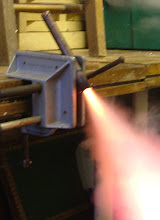

East Cliff at West Bay, Dorset. Reminiscent of a giant coffee flavoured vienetta from a '70s suburban dining room, these cliffs are a great starting point for the journey into the topic of geology - no digging, climbing, drilling or blasting required. Approximately 48 metres of Bridport Sands in the Upper Lias, deposited as marine sediment at the rate of around 20,000 years/metre, present us with a million year snapshot of the Jurassic period. Particularly useful for the enthusiastic student is the way the calcite-cemented beds have demonstrated their increased durability by standing proud, step-like against the elements and offering some scale to the picture. The general brown appearance of the sandstone is caused by oxidisation on exposure to the atmosphere, the stone losing its natural blue/green colour. At the very top overlying beds of limestone, an Inferior Oolite, form the icing. Also at West Bay, in a great restaurant, can be found some of the freshest Sea Bass you're likely to come across. MORE ROCKS !

1 comment:
Lovely post. I always like the layer cake geology lesson that is the cliffs at Hunstanton. Or are the cliffs at Hunstanton. Or...(falls asleep over desk strewn with rock samples, little hammers and a dog-eared paperback of John Fowles' The French Lieutenant's Woman.)
Post a Comment